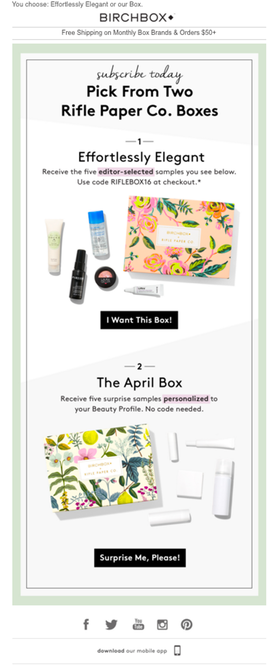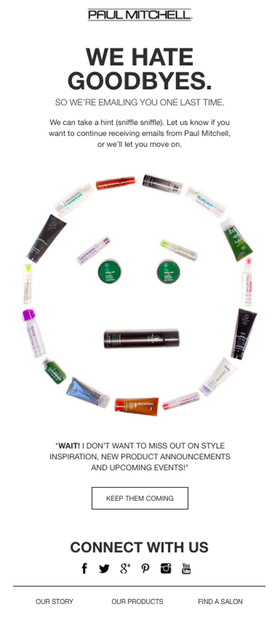How to Build An Email for Abandoned Cart Users
Did you know? Up to 46.1% of people open cart abandonment emails. Here are tips and tricks for writing an abandoned cart email.
Read More
When subscribers aren’t engaging with your marketing emails, it’s essential to re-engage them before they’re gone for good. Not only will you lose business from the 44% of customers who drop out of brands’ email lists in their first year of signing up, but if your engagement levels decrease considerably, internet service providers (ISPs) may label you a low-quality sender.
What can you do to slow the leak? Win back your customers with re-engagement email campaigns.
Before you start a re-engagement email campaign, you need to know who your inactive subscribers are. Depending on your business, you can categorize inactive subscribers as:
Those who haven’t opened your emails for a given period (e.g., three to six months)
Those who haven’t opened a certain number of your most recent emails
Those who open your emails but never click links or make a purchase
Categorize your inactive subscribers according to their actions and how they subscribed to your email. Next, analyze their past browsing and purchase history and their demographic, such as age, location, and gender. Finally, think about your business model, buying cycle, and what behavior you’d expect from your prospects. Once you know what motivates your customer, you can personalize a re-engagement email campaign that entices them.
You can automate the segmentation of your email list by types of inactive subscribers and then send them personalized re-engagement email campaigns. Usually, you’d want to send about three emails spaced a week or two apart (assuming they don’t engage). For customers who engage by opening your email, clicking on a link, or visiting your website, you’ll want to send them on a different email follow-up path from those who remain inactive.
Pro tip: your re-engagement email campaign should be as personalized as possible. Some ways of personalizing include referencing products your customers have bought or viewed in the past and recommending specific products. Also, always address email subscribers by their first name or call out their company's name in the email.
Let’s assume you’ve decided on a three-email re-engagement campaign. While there’s no set format, you need an attention-grabbing subject line, compelling body copy, and a strong call to action (CTA). And it doesn’t hurt for all your emails to encourage your audience to follow you on social media. Below is an example of what you might consider:
Grab their attention in whatever way you think will work best for that customer. For example, you might show them new items related to previous purchases, share links to relevant guides or whitepapers, or offer them other helpful content.
If you have a direct-to-consumer (D2C) business, consider offering a choice of products with an element of surprise. For example, Birchbox shows its customers two different beauty product boxes in the email. One image displays the contents of the box, and the other image shows a surprise box that’s “personalized to your beauty profile.”

Shoppers love surprises, and Birchbox uses that emotional instinct to drive re-engagement.
Ask your customers to indicate their preferences for the content of emails they receive and the time they arrive. You might also ask how frequently they want to receive emails (e.g., several times per month vs. a bi-monthly digest).
Ask your customers why they aren’t engaging. Did they expect their email subscription would have a different type of content? Have their circumstances changed? What would it take for them to engage? What do they want from your content? What problems do they have that you may be able to help them with?
Once again, provide value in the form of a link to helpful information.
You can also ask your customers to update their preferences in this email if you didn’t in email one or if they failed to do so. Remind them that they signed up for your list. Many people forget.
Point out new services, products, and benefits, particularly if they relate to the customer’s interests:
Do you offer new customer service options?
Do you have a new loyalty program?
Are you carrying an exciting new product line related to a purchase they made in the past?
Create urgency in your last email. Tell your customer this is the last email from you if they don’t indicate they want to keep receiving them.
Give them a last chance to update their email preferences.
Consider making your customers an offer they can’t resist. This could be a discount, free shipping, a free add-on when they buy a particular product, or anything else appealing. Of course, you’ll want to mention the offer in the subject line of your email.

An example of a final “Breakup Email” from Paul Mitchell — the sad face really tugs on your heartstrings, doesn’t it?
Sometimes people don’t open their emails because of the timing. Analyze your data — when are people opening your emails most often? Test different times. And, as already mentioned, give your customers choices regarding when they’d like to receive emails and how often. There isn’t a universal “best” time, but it depends on whether you’re sending emails to consumers or business executives.
As with any email campaign, you’ll want to do A/B testing for every element of your re-engagement email campaign content, as well as the timing and frequency.
Let’s assume your email campaign was successful, and some of your customers are re-engaged. Add these people to a list where you’ll send them tailored emails that lead them to convert and buy rather than just leaving them on your general subscriber list.
For those who didn’t re-engage, there’s no sense in wasting more time or money on them. You gave it your best shot, and it’s time to delete them from your list. Leaving inactive subscribers on your list will weigh down your ratings with ISPs, and maintaining a database of inactive accounts can become very expensive in the long term. Re-engagement email campaigns should be an ongoing part of your marketing outreach.
Fortunately, we can help you use email contacts for better advertising. For Klaviyo customers, we can import Klaviyo lists and segments for coordinated ad targeting on display, Facebook, Instagram, TikTok, and Pinterest.
By importing metrics, we help customers analyze email performance alongside their AdRoll ads campaigns.
Our CCA dashboard can help you attribute across all of your marketing channels — ads, email, SMS, social, search, and more.
Last updated on January 30th, 2025.